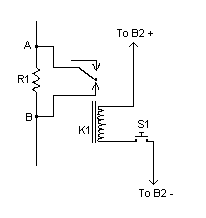The simplest of all motor controllers (besides a straight on/off switch)
is the contactor controller. I designed this contactor controller for
use in my electric scooter
project. It is based around three 12V relays, two 12V batteries, two
switches and of course a motor. Having no silicon to "fry", it is quite
reliable and robust. A contactor controller works by rearranging the two
(or more) supply batteries between series and parallel. This gives the
motor a slow speed (batteries in parallel, current adds) and a fast
speed (batteries in series, voltage adds). This assures that both
batteries are discharged equally. When the circuit is "at rest", the
batteries are connected in parallel, which allows easy recharging.
 |
Schematic
|
Notes
- S1 closes K3 and thus causes M1 to operate. S2 activates K1 and K2,
reconfiguring the batteries for series operation and thus causes M1 to
operate at "fast" speed.
- B1 and B2 should be chosen based on the current requirements
of M1. Often, sealed lead-acid type batteries are available at local
suppliers for surprisingly low prices. These batteries are ideal for
things such as scooters, go-karts, etc.
- The relays are standard automotive type relays, available cheaply from any auto parts store.
- Your motor will depend on your requirements. 12V motors will normally run fine at 24V, and vice versa.
- You will notice that in series mode, all three relays only
pull power from B2. This is because the relays have 12V coils, and it is
impossible to switch the batteries from series to parallel and keep
power to the coils at the same time. This does, however, mean that B2 is
discharged slighty before B1. This should normally not be an issue
unless the batteries are being drained completely "dead". Draining a
battery dead is not good for it in any situation, and should be avoided. If you wish, you can use a small 12V battery to run the relays separately.
- You can add two more speeds to this controller using the
schematic below. It connects at points A and B shown above on the
controller schematic.

K1 is simply another of the same relay as used in the controller. S1 is
another switch. R1 needs to be chosen based on your motor, but it will
be of low value (under 10 Ohm) and high wattage (normally at least
100W). It must be capable of handling the full current drawn by the
motor. This is not exactly an efficient way to limit current to the
motor as excess current is dissipated as heat by the resistor, so it is
normally only used for a "starter" speed.
|
Part
|
Total Qty.
|
Description
|
Substitutions
|
| K1, K2, K3 | 3 | 12V 30A SPDT Relay (See Notes) |
|
| S1, S2 | 2 | SPST Switch or Button |
|
| B1, B2 | 2 | 12V Battery (See Notes) |
|
| M1 | 1 | 12V or 24V Motor (See Notes) |
|
| MISC | 1 | Case, Wire, etc. |



No comments:
Post a Comment